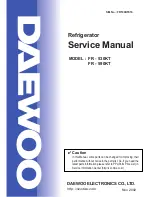
Instructions for the User
44
12.SOME HINTS FOR SAVING MONEY
The following is some simple, practical advice which will allow you to run your refrigerator to best effect,
with peak performance and lower power consumption:
1) Place
the refrigerator in the coolest part of the kitchen, well away from the cooker, radiators and the
window, to protect it from variations in temperature.
2) The correct distance from the wall
is at least 5 centimetres. This leaves enough room around the
refrigerator for effective ventilation, necessary to prevent overheating and high power consumption.
3) Set the thermostat
on intermediate settings. Colder settings increase power consumption by 10/15
per cent. We recommend the following settings: set a value of 5 for the refrigerator section, while the
recommended setting for the freezer is -18.
4) If you open the refrigerator often
and always keep it full, set the thermostat on a slightly colder
temperature.
5) Never place food
touching the sides of the refrigerator.
6) Do not place foods inside the refrigerator
when they are still hot. This would tend to cause ice to
form on the sides.
7) Cooked foods must be sealed
in airtight containers, left to cool and then placed on one of the
refrigerator's middle shelves.
8) Foods must be properly
protected. Keep milk, butter and packaged cheeses in their original packs.
Clean bottles and cans before placing them in the refrigerator. For other products, use food-approved
paper or bags for vegetables; shop wrappings should not be used.
9) The coldest area
is at the bottom; arrange foods depending on their storage requirements. For
example, fish and meat should be placed above the vegetable container and cheese and eggs in the top.
10) Fish must always be cleaned
and gutted before storage. Minced meat must be in an airtight
container.
11) Eggs may be infected
with salmonella, and so they should not be touching other foods. Always keep
the egg holder and the shelf which supports it thoroughly cleaned.
12) Store vegetables intact.
Cutting them tends to cause them to deteriorate more quickly, and they
also lose their vitamins and mineral salts. Wash fruit and vegetable to remove any soil, dry thoroughly
and then place in the refrigerator in paper bags to aid breathing and reduce moisture.
13) Bananas
turn black if stored at temperatures below 12 degrees. If it is very hot, it is best to put them
in the refrigerator wrapped in food-approved paper.
14) Foods have different storage lives.
Eggs will keep for up to a month but cheeses, fruit and
vegetables should be used within a week, cooked foods within three days and meat and fish within two-
three days.
15) Take out or insert food quickly.
Every time you open the door it costs money. It will take time and
electricity to reduce the temperature to the same level.
16) After disconnecting the power supply
, make sure that the condenser and the coil on the back of
the appliance are clean. The layer of dust which forms disperses the low temperature and considerably
increases power consumption.
17) The layer of ice inside
must not be more than 5 millimetres thick. If necessary, defrost the
appliance to prevent formation of an insulating layer which would increase power consumption. For the
defrosting procedure, read points “11.1 Defrosting the refrigerator section” and “11.2 Defrosting the
freezer section”.

































